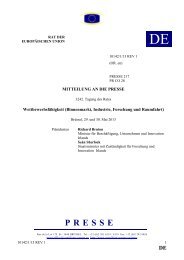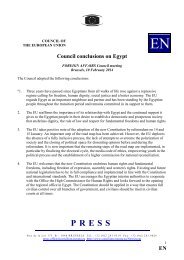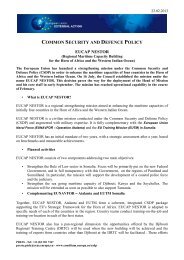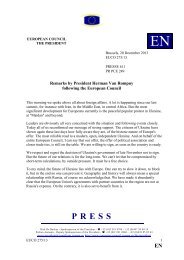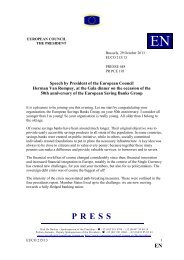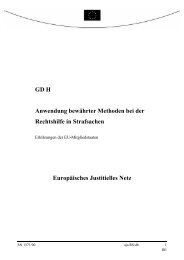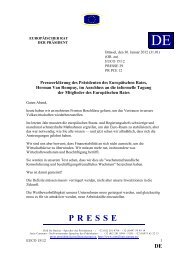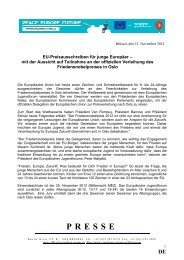14508/09 ADD 1 PL/vk 1 DG G COUNCIL OF THE ... - Europa
14508/09 ADD 1 PL/vk 1 DG G COUNCIL OF THE ... - Europa
14508/09 ADD 1 PL/vk 1 DG G COUNCIL OF THE ... - Europa
You also want an ePaper? Increase the reach of your titles
YUMPU automatically turns print PDFs into web optimized ePapers that Google loves.
While women’s total employment rates are lower than men’s in almost all EU countries, the<br />
differences decrease with increasing levels of education. The EU-average employment rates of<br />
women with tertiary education (25-39 years) are 84 %, of women with secondary education 72 %<br />
and of women with only basic schooling 51 % (see figure 4.2.4). The corresponding figures for<br />
women of 40-64 years are 80, 65 and 43 %, i.e. the employment rate is somewhat lower for the<br />
older than for the younger women. While this difference is also observed for men, the gap is<br />
smaller: an employment rate of 92 % for those with tertiary education aged 25-39 compared with<br />
80 % of those with only basic schooling, and for those aged 40-64, 86 % and 66 % respectively.<br />
Nevertheless, there remains a gap in employment rates between women and men with the same<br />
educational background, although it is much narrower among those with tertiary education than<br />
among those with only basic schooling. In 2006, the gap amounted to 8 percentage points among<br />
25-39-year olds in the EU as a whole, ranging from 22 percentage points in the Czech Republic, 19<br />
in Hungary, 17 in Slovakia, 2 in Lithuania to 1 percentage point in Romania (Eurostat, EU-Labour<br />
Force Survey). In countries where the employment gap is wide, the employment rate of the women<br />
in this group is relatively low, which means that valuable human capital is not being used.<br />
The gender employment gap for persons with tertiary education is slightly narrower in the EU for<br />
those aged 40-64 than the average for those aged 25-39, in part reflecting the fact that the older age<br />
group have fewer care responsibilities. In the EU as a whole, the employment rate of women with<br />
tertiary education aged 40-64 was around 6 percentage points lower than for men. The variation<br />
between countries is slightly wider in this group; from -1 percentage point in Sweden and Finland to<br />
24 percentage points in Malta.<br />
Low-educated women’s employment rates differ widely among the EU-countries. In Portugal the<br />
rate of employment for women in the 25-39 age group is 73 %, while in Slovakia it is 21 %; and<br />
among women of 40-64 years it varies between 63 % in the UK to 17 % in Malta. The pattern is the<br />
same for women with secondary education, but at a higher level of employment and with smaller<br />
differences between women and men and between women in different age groups.<br />
Women with only basic schooling are far more likely than men to be outside the labour market.<br />
<strong>14508</strong>/<strong>09</strong> <strong>ADD</strong> 1 <strong>PL</strong>/<strong>vk</strong> 60<br />
ANNEX <strong>DG</strong> G EN





